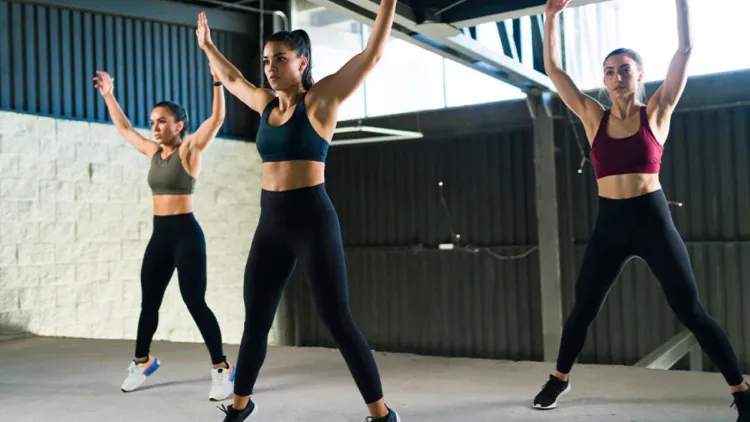Jumping jacks are not simply a warm-up. They increase cardiovascular health, enhance bone strength, stimulate metabolism, burn calories, and aid in weight loss. They can enhance endurance and tone the body, burn belly fat, and help maintain mental health because they need no equipment and do not require much space to be performed every day.
What are jumping jacks?
Jumping jacks should be no stranger as they are one of the oldest common exercises taught in many childhood gym classes. Although they appear easy, the benefits of jumping jacks are much more than just a typical warm-up exercise. Full body exercise that provides cardiovascular workout, bodybuilding and coordination. Jumping jacks can give you all these benefits, with no equipment required and very little space needed to perform them.
In this article, we will not only explain all the benefits of jumping jacks in detail but also how they affect weight loss, belly fat, bone strength, psychological well-being, and overall fitness, as well as answer important questions such as how many jumping jacks should one perform each day, possible side effects of jumping jacks, and whether they can substitute other types of physical activity, such as running or walking.

1. Cardiovascular Health Boost
The main benefits of jumping jacks are that they affect cardiovascular fitness. Every time you jump, your heart rate speeds up, increasing the amount of oxygen pumped with your blood. In the long term, this makes the heart strong, better circulation and reduces the chances of developing heart problems.
In case you were to do approximately 100 jumping jacks a day, you would soon notice the endurance and stamina improvement. The reason is that regular aerobic exercise teaches your body to utilise oxygen more effectively, so simple things such as going up the stairs or even carrying groceries no longer feel so tiring. Jumping jacks are considered more intense exercises compared to walking, giving your heart a good workout, and less time would be required before a positive result is achieved.
2. Full-Body Workout
In contrast to isolation exercises, when only the training of a single group of muscles is involved, jumping jacks are performed with the involvement of practically all aspects of your body. Your calves, quadriceps muscles, and gluteals propel the jumps, your hips and shoulders rotate with a swinging motion, and your core muscles are used to steady your actions.
This qualifies jumping jacks as a perfect toning exercise. Although they do not develop six-pack ab muscles directly, the repeated involvement of the core works the abdominal muscles to promote the look. They also enhance improved flexibility, particularly the hip flexors together with the shoulders, as your whole body is now moved through a wide range of movement with every single repetition.
When practised regularly, jumping jacks will aid in creating an overall slimmer and more toned body and can be conducted without heavy weights and machines.
3. Burns Calories and Supports Weight Loss
The benefits of jumping jacks in relation to weight loss are that they help to burn calories in a short time. The average individual is able to burn about 8-10 calories every minute based on body weight and the intensity of the activity. This implies that 100 jumping jacks could burn as many as 20-25 calories. Although that might not sound like a big figure, several sets throughout the day can make a considerable difference.
To get things into perspective:
- It takes approximately 7700 calories to make 1 kg of body fat.
- To burn 1 kg via exclusively exercise, you would have to burn about 1 kg.
- Regular jumping jacks, together with a calorie-restricted diet plan, can help you achieve this goal in the long run.
They might not be the absolute highest calorie-burners–more can be attained with burpees and sprinting–but jumping jacks are simple, attainable, and safe to perform in any location.

4. Improves Coordination and Balance
Jumping jacks are seemingly simple, but ensure that other parts of the body are in synchronisation as the patient moves, such as the arms and legs. Repeating them daily improves motor coordination, balance, and rhythm, which contribute to improved sports abilities and everyday tasks such as walking, jogging, or lifting a heavy object.
This is of great value to older adults since balance problems can be corrected, leading to diminished falls. In children, it increases coordination and readies them to do more demanding physical games.
5. Strengthens Bones and Joints
The frequent strike of impact of every jumping jack repetition makes bones denser, similar to jogging or skipping. Healthier bones would reduce the possibility of developing osteoporosis in later years. The movement also builds ligaments and tendons around the ankles, knees and hips and keeps joints in motion and in control.
Nonetheless, they should be done properly, and soft landings should be done to reduce unwanted stress on the joints. Activities are lower-impact options that those with existing knee issues can consider.
6. Increases Flexibility
Jumping jacks in a big range of motion promote flexibility on the shoulders, chest and hips. This can assist in avoiding stiffness when sitting or working long hours at a desk. A regular practice also helps to improve posture as supportive muscles in the back and core are strengthened, and movement through the day feels easier and less uncomfortable.
7. Boosts Mental Health
Aerobic activities such as jumping jacks will release endorphins, which are the natural mood enhancers in the body. Even a few minutes can remove stress, sharpen concentration, and help take the edge off anxiety. Simply making room to fit in jumps or jumping jacks on occasion can be the boost needed to give someone the energy they need to continue their day or get them the jolt that they need to wake up.
Even some studies posit that regular cardio gymnastics assists in hormone levels and puts a damper on stress-related cortisol and subsequent hormonal belly weight gain.

8. Easy and Accessible
Jumping jacks are one of the least appreciated benefits of jumping jacks are easy to perform. You do not have to pay a fee to train in a gym, get special equipment, or occupy a wide area. You can do them at home, in the office or when outdoors and anywhere in between.
This would make them suitable for people who have limited time to commit to workouts and would not want to spend too much money on the gym. When compared with running, which requires a track or treadmill, or walking, which involves more time to burn calories, jumping jacks help as they require little time and have a high-intensity level.
How Many Jumping Jacks Should You Do Daily?
The success of jumping jacks depends on the regularity and intensity. Absolute beginners may begin with 3 sets of 30 to 50 repetitions and build up to 100 to 200 over the day. To shed off the extra fat, other manoeuvres such as squats, planks, and burpees are equally applicable in enhancing the overall workout.
The best exercises to get rid of belly fat fast are jumping jacks, which should be combined with calorie calorie-deficient diet, as no exercise will result in losing fat in one area. Whilst the reduction of fat around the belly ultimately depends on the overall fat loss, which occurs when an individual burns more calories than what he/she take in, it is important to note that belly fat responds differently compared with other fats in the body.
It would take a whole host of exercises (e.g., running, HIIT, cycling, and jumping jacks) to use up 1,000 calories of energy in a day, rather than a single exercise. Although jumping jacks are a sure way to add to your daily burned calories.

Are Jumping Jacks Better Than Running or Walking?
Running and jumping jacks are very good cardio activities, but are used differentially. Running tends to burn many calories in a minute, but it needs more space, and it can be less taxing on the knees. Walking is gentler, but it burns fewer calories and takes longer to record the same effect.
Jumping jacks are more combo-friendly: they are more energetic than walking but less intensive than running, and you can do them anywhere. To some, that is a more sensible trade-off.
Potential Side Effects and Precautions
The benefits of jumping jacks are quite clear, but, like anything that can be done, they also have their pitfalls as well as risks when executed in the wrong way or too much. Potential disadvantages are as follows:
- Joint strain: Failing to land softly may affect the knees and the ankle.
- Pain in Your Lower Back: The abdominal muscles will be weakened, and the lower back will be strained.
- Overuse injuries: fatigue may occur when one overworks.
To avoid adverse effects, it is critical to wear the right type of shoes, warm up first and build up intensity in stages.

Final Thoughts
The benefits of jumping jacks combine with the universality and variety of ways to implement the exercise to make the move one of the most useful and effective ones you can incorporate into your fitness routine. They help to build heart strength, burn calories, tone muscles, increase flexibility and enhance mental wellbeing. Although they may not perfectly develop a set of six-pack abs or a flat stomach alone, when performed along with a balanced diet and other exercises, abdominal exercises do play a big role in helping to lose weight and become fit.
Jumping jacks can be an excellent solution when you need an easy exercise in a no-equipment workout that you can do on any schedule. As little as a few minutes a day can help you stay energised, lean and healthier in the long run.
Frequently Asked Questions
1. Will I lose belly fat when I do jump jacks every day?
Yes, jumping jacks can make you burn calories and improve metabolism, which is part of overall fat loss, including belly fat loss. Yet there is no such exercise that would allow working specifically on belly fat. The significant advantage emerges when jumping jacks are used along with a diet that induces a calorie deficit and other strength or cardio training.
2. How many jumping jacks are necessary to do each day to lead to the effect?
Beginners should exercise with 3 sets of 30-50 reps and gradually increase it to 100-200 jumping jacks on a daily basis. Doing it regularly is important: consistency will help get the best out of jumping jacks in terms of endurance, fat burning, and muscle toning.
3. Are jumping jacks superior to reading, running, or walking?
The reason that jumping jacks are not like walking or running is that they are intermediate in terms of the challenge. Although jogging tends to consume more calories per minute, jumping jacks can be done in almost any place without the aid of machines or a lot of space. They are more vigorous as compared to walking, with the great benefits of heart-pumping conditions.
4. Which side effects can be caused due to an excessive amount of jumping jacks?
Although jumping jacks offer many benefits, the side effects include straining of joints and aching of the lower back and are a result of excess jumping. To prevent side effects, it is important to take care of correct form, wear supportive shoes, and introduce an intensity increase gradually.







